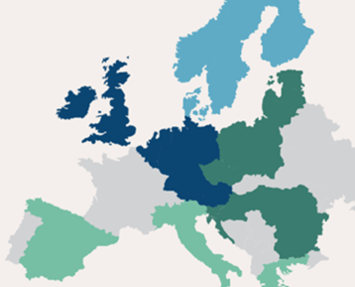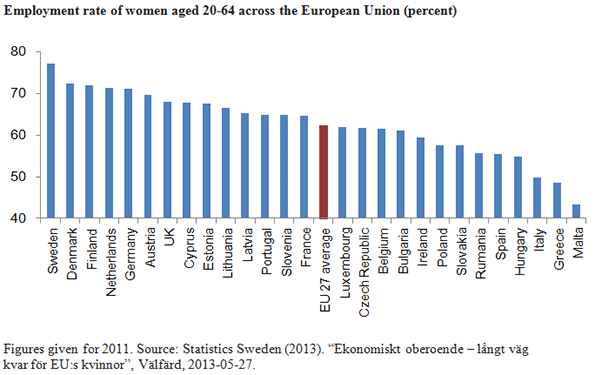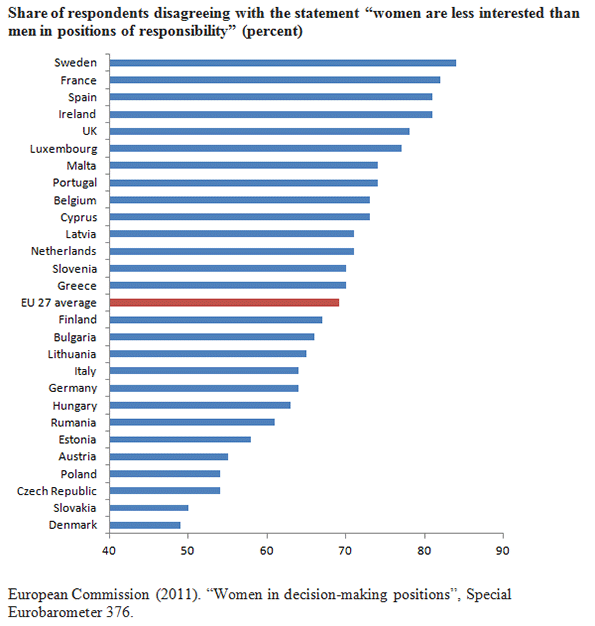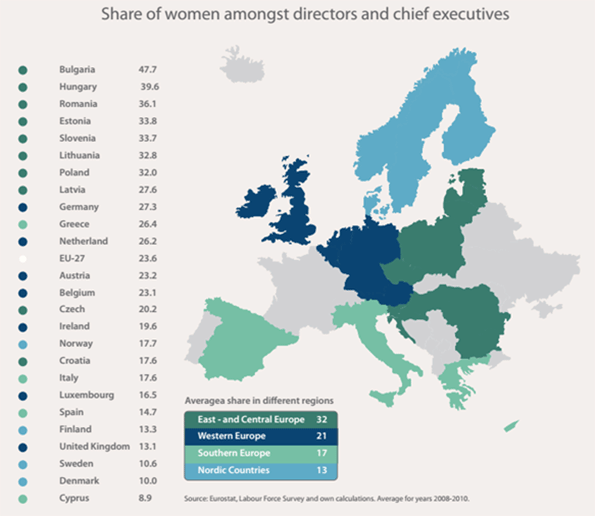
A great divide exists between European countries when it comes to the issues of women’s career opportunities. Some countries have high female work participation and values that promote gender equality, while others lag behind. But a closer look shows that the share of women in managerial positions is in odds with other indicators of equality. Scandinavia, where we might expect to find most female directors and chief executives, has in fact the lowest share. Many more women have reached the top of the business sector in countries with relatively low female labor participation, and far from gender equal attitudes. Other factors, such as the scope of welfare state monopolies and hours invested in work, seem to crucially affect women’s chances to reaching the top of the business world.
The European Union has set the goal to achieve an employment level of 75 percent amongst women. So far, only Sweden exceeds this ambition with an employment level of fully 77 percent. Denmark, Finland, the Netherlands, Germany and Austria follow closely behind. In these five countries seven out of ten women working age are employed. It doesn’t seem a coincidence that these northern European nations share similar cultural and political attributes. The expansion of welfare states has historically encouraged womens’ entry into the workforce. Still today public childcare encourages women to invest time at work, whilst high taxes make it difficult to live on only one salary.


Overall, the Eastern- and Central European countries have a lower share of women working, since it is more common with housewives. The three former Soviet states Estonia, Lithuania and Latvia are in particular interesting to look at. Not only are they Eastern European, and strongly committed to low taxes and free markets, but they also share Nordic cultural attributes. The three Baltic states have a respectably high level of two thirds of women in employment. This is somewhat higher than the European average, and considerably more so than in parts of Southern Europe. In Malta and Greece, fewer than half of the women work. In Italy exactly half of them do.
Northern and Western European countries also tend to have more equal gender attitudes. A special edition of the Eurobarometer has focused on the issue of women in decision-making positions. One key indicator is how many disagree with the statement “women are less interested than men in positions of responsibility”. Sweden again stands out, with 84 percent of the public disagreeing with this notion. Although culturally and politically similar Denmark is found at the other end, with only 49 percent disagreeing with this idea, the overall trend is clear. The general publics in Nordic and Western European countries more strongly reject the notion that women are less interested in reaching positions of responsibility while Southern-, Eastern-, and Central European countries are found at the opposite end of the spectrum.
We would expect to find many more women in top positions in the egalitarian Nordic nations, as well as Germany, the Netherlands and other similar countries. And indeed we do. At least when it comes to politics, the public sector and company boards. All too often the analysis stops here. But it is important to realize that representation on boards is a poor measure of women’s progress in the private sector of many European countries. Many boards in Nordic nations for example have relatively formal roles, meeting a few times a year to supervise the work of the management. The select few who end up on the boards – many of whom reach this position after careers in politics, academics and other non-business sectors – enjoy prestigious jobs. They are however not representative of those taking the main decisions in the business sector. The latter role falls on executives and directors. Public sector managers tend to have less overall power, working within the scope of large bureaucratic structures.
Chief executives and directors in the private sector are responsible for taking much of the crucial decisions in the business world. One typically only reaches a high managerial position after having worked hard in a certain sector, or successfully started or expanded a firm as an entrepreneur. The share of women reaching this position is a good proxy of women’s opportunities in the business world as a whole.
Astonishingly, the data show that the gender equal Nordic nations all have lower levels of women at the top of businesses than their less progressive counterparts. In Sweden and Denmark, only one out of ten directors and chief executives in the business world are women. Finland and the UK, two other nations with large public sector monopolies, fare only slightly better.
In contrast, in the average Eastern- and Central European country fully 32 percent of the directors and chief executives are women. This can be compared to 21 percent in Western European countries, 17 percent in Southern European nations and merely 13 percent in the otherwise egalitarian Nordic nations. In Bulgaria, with lower than EU-average levels of female work participation, and not a bastion of egalitarian attitudes, women fill almost half the positions.

It should be noted that other measures of the share of women at top of businesses supports this general trend. Eurostat for example also publishes a broader measure of business leaders, including also middle-managers. In the Baltics Estonia has the lowest share of women in these positions, 36 percent. Lithuania and Latvia fare better with 39 and 45 percent respectively. In Sweden the share is 35 percent and in Denmark 28 percent. Based on interviews with 6 500 companies around the world, the firm Grant Thornton estimates that around four out of ten managers in the three Baltic nations are female, compared with around a quarter in the Nordic nations. The overall picture is clear: fewer women in the Nordic nations reach the position of business leaders, and even fewer manage to climb to the very top positions of directors and chief executives.
How can egalitarian Nordic countries, in most regards world leaders in gender equality, have the lowest rates of female directors and chief executives, whilst the nations in Eastern- and Central Europe are leaders in the same regard? I have previously touched upon this perhaps unexpected relation in the Swedish book “Att Spräcka Glastaken” (Breaking the glass window), a short report in English co-authored with Elina Lepomäki for Finnish think tank Libera and also in a column for the New Geography.
Key here is the nature of the welfare state. In Scandinavia female dominated sectors such as health care and education are mainly run by the public sector. The lack of competition has not only reduced the overall pay, but also lead to a situation where individual hard work is not rewarded significantly (wages are flat and wage rises follow seniority, according to labour union contracts, rather than individual achievement). Some opportunities for entrepreneurship do exist, as private competition has been allowed in particularly the Swedish welfare sector in recent years. But overall, the Nordic political systems still create a situation for many women where their job prospects are mainly limited to the public sector . Women in Scandinavia can of course become managers within the public sector, but their wages and influence in these positions are typically more limited compared to in private enterprises.
The former planned economies in Eastern- and Central Europe are well behind in terms of female employment and attitudes. But they have also since the times of socialist economies had systems where women who are employed work almost as many hours as the men. During recent years the nations have transitioned to market economies, in many regards more free-market systems than in other European countries. Employed women have continued to invest heavily in their workplaces in the former planned economies.
The situation is quite different in the Nordic welfare states, where high taxes and public benefits create incentives for women to work, but often to work relatively few hours. For example 10 percent of the employed women in Latvia and Lithuania, and 14 percent in Estonia, work part time. In Sweden, the share is fully 41 percent. To put it differently, the average employed man in the Scandinavia works between 16 percent (Finland) and 27 percent (Norway) hours more than the average woman. In Lithuania the same gap is 13 percent, and in Latvia and Estonia merely 7 percent. Bulgaria is unique as the only European Union nation where women actually work more (1 percent more) hours than men. Women in Eastern- and Central Europe reach managerial positions by working hard and, contrary to the men, staying away from alcohol and other social ills.
To reach the top of the business world, high employment and gender equal values are not enough. These factors must be complemented with political structures that allow for competition and entrepreneurship, as well as systems where women in their careers are encouraged to invest the time needed to climb the career ladder. It is quite telling that the Baltic nations, as well as other Eastern- and Central European countries, manage to outperform the rest of Europe in their share of female directors and chief executives. They do so by having systems with limited public monopolies and smaller differences between hours worked by men and women. It is equally telling that the Nordic nations underperform in the same regard, as their Social Democratic systems encourage many women to work, but hinder them from reaching the top of the business world. The map of gender equality in Europe is more complex than it might appear at a first glance.
Dr. Nima Sanandaji has written two books about women’s carreer opportunities in Sweden, and has recently published the report “The Equality Dilemma” for Finnish think-tank Libera.












